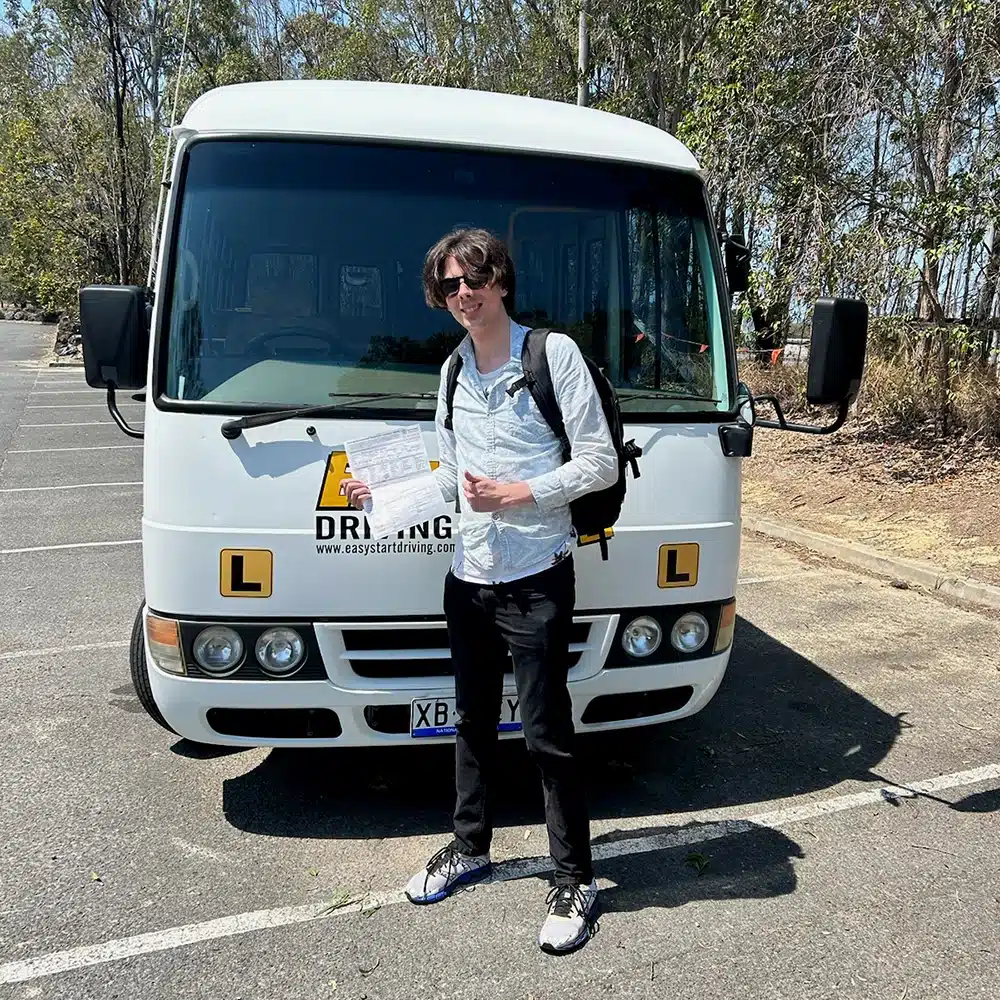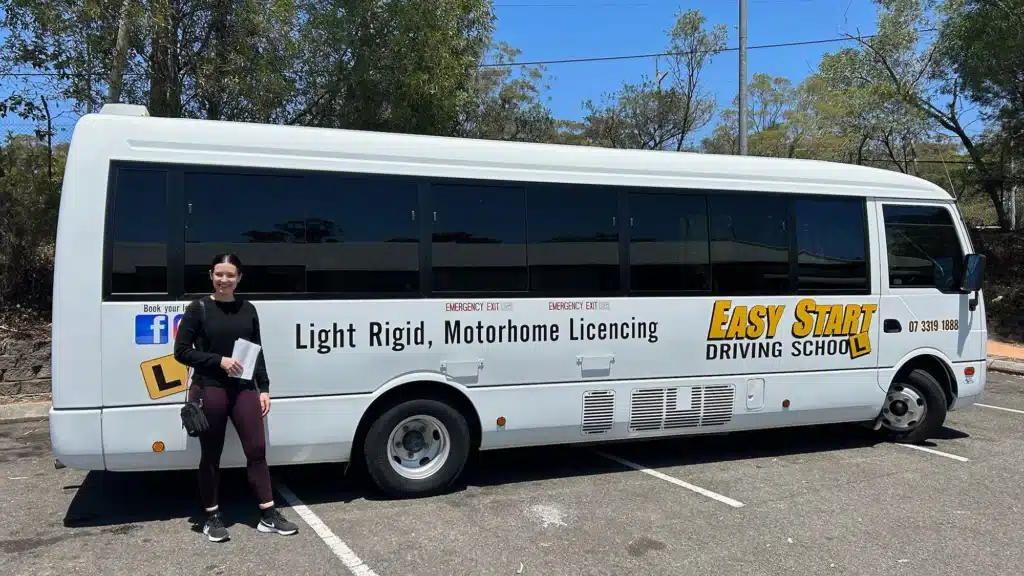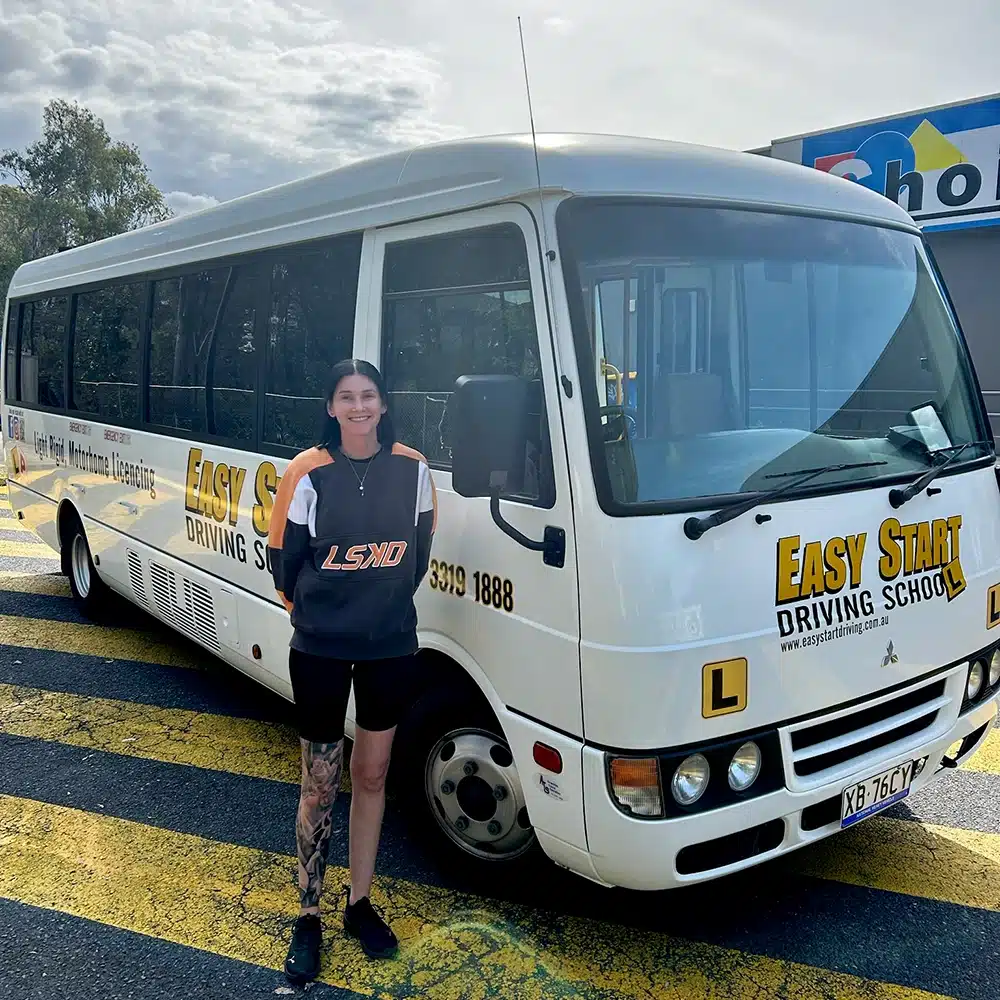
Light Rigid Driver Training
If you’re looking to move into the transport industry a Light Rigid Driver Training Course on the Gold Coast will boost your skills and increase your career opportunities.
Easy Start Driving School is your expert Light Rigid Driver Training partner on the Gold Coast.
Whether you’re driving around a football team, transporting patients or taking tourists to and from the airport our expert Driving Instructors will guide you through comprehensive training programs tailored to your needs, ensuring you become a confident and skilled driver for those you serve in a Light Rigid vehicle.
Andrew Mitsi -
Founder of Easy Start Driving School
Driving a Light Rigid vehicle is a unique experience that requires a different skill set compared to driving a standard passenger car.
Light Rigid vehicles are typically larger and heavier, with a higher centre of gravity, which affects their handling characteristics. Understanding these differences is crucial for safe and confident driving.
In this section, we’ll delve into the specifics of Light Rigid vehicles, exploring what sets them apart from other vehicle classifications.
Light Rigid vehicles are defined by their Gross Vehicle Mass (GVM), which ranges from 4.5 to 8 tonnes. This category includes vehicles like vans, small trucks, and buses designed to carry more than 12 passengers.
One of the key differences between Light Rigid vehicles and smaller vehicles is their size and weight distribution.
Light Rigid vehicles require wider turns and longer braking distances, and they may be more prone to tipping if not driven with care. Therefore, it’s essential for drivers to understand the vehicle’s dimensions and limitations to manoeuvre safely on the road.
Additionally, the legal requirements associated with driving a Light Rigid vehicle. In Australia, individuals must hold a specific Light Rigid vehicle license to operate these vehicles legally.
Our training programs cover the knowledge and skills needed to obtain this licence, ensuring drivers are compliant with all relevant regulations.
Mastering the control and manoeuvrability of Light Rigid vehicles is crucial for safe driving, especially on the busy roads of the Gold Coast.
This section focuses on advanced driving techniques specifically designed for handling Light Rigid vehicles in various driving conditions.
Our training programs include practical lessons on precision steering, effective braking, and safe reversing.
We emphasise the importance of spatial awareness and how to accurately judge distances and angles, which are critical skills when navigating through tight spaces or during complex manoeuvres like parallel parking or reversing into loading docks.
Understanding the dynamics of Light Rigid vehicles, such as how load distribution affects handling and stability, is also covered.
We provide tips on securing cargo properly to prevent shifts that could unbalance the vehicle.
Furthermore, our Driving Instructors offer insights into the latest vehicle technology aids, such as stability control and anti-lock braking systems, teaching drivers how to leverage these tools to enhance safety.
By focusing on these advanced techniques, we prepare our students to handle Light Rigid vehicles with confidence, whether they’re driving on congested city streets or navigating challenging rural roads.
Light Rigid truck drivers are essential to the transportation industry, but their work can also be risky.
Drivers of Light Rigid trucks must be aware of their surroundings at all times, watch for potential dangers, and take action to avoid crashes.
Maintaining situational awareness is the first step in hazard perception. Drivers of Light Rigid trucks must be aware of their surroundings at all times, including other cars, pedestrians, bicycles, and road conditions.
Light Rigid Drivers should constantly scan their surroundings, check their mirrors, and use their rearview camera to stay informed.
Drivers of Light Rigid trucks must be able to recognise potential hazards and take action to mitigate them. This includes keeping an eye out for pedestrians and bicycles, especially in low-speed areas like school zones and shopping centres.
Drivers should also be aware of road conditions such as potholes, gravel, and oil slicks, which can cause a truck to lose control.
Maintaining a safe following distance is critical for avoiding accidents. Drivers of Light Rigid trucks should leave enough space between their vehicle and the vehicle ahead to allow for stopping time in an emergency.
The three-second rule is a good rule of thumb: choose a fixed point on the road ahead, such as a sign or a marking, and begin counting when the vehicle ahead passes it. If your vehicle reaches the fixed point before you’ve counted to three, you’re following too closely. Allow additional space during poor weather conditions.
Checking your mirrors and blind spots regularly is critical for hazard perception. Drivers should check their rearview and side mirrors frequently to stay informed about their surroundings.
Drivers should also check their blind spots by glancing over their shoulders to ensure no vehicles are in their blind spots.
Reducing speed is critical for hazard perception. Drivers of Light Rigid trucks should reduce their speed in low-speed zones, such as school zones and shopping centres, and when weather conditions are poor. Drivers should also slow down when driving through roadwork or areas with heavy pedestrian traffic.
Using your indicators is an important aspect of road safety. Drivers of Light Rigid trucks should always signal their intentions to other road users, whether turning, changing lanes, or merging.
This allows other road users to anticipate the driver’s next move and react appropriately.
Distracted driving is a major cause of accidents. Drivers of Light Rigid trucks should avoid distractions such as using their phones, eating, or engaging in conversations with passengers while driving.
Drivers should focus on the road and avoid engaging in activities that could distract them from their surroundings.
Obtaining a Light Rigid vehicle licence is just the beginning of your journey as a safe and responsible truck Light Rigid driver.
It is vitally important to develop and cultivate safe driving habits that extend beyond the requirements of the driving test.
Holding a Light Rigid licence opens up a new world of driving possibilities, catering to those who aim to navigate the roadways not just as a driver but as a professional steering towards a career in transportation.
This licence is your ticket to operating a diverse range of vehicles, expanding your employability and versatility in the driving industry.
With an Light Rigid licence, you’re authorised to drive vehicles with a gross vehicle mass (GVM) between 4.5 tonnes and up to 8 tonnes.
This range includes an array of vehicles designed for specific functions, from logistics and delivery services to public transportation and niche travel services.
Notably, you can find yourself behind the wheel of small trucks, which are integral to local and interstate delivery networks, supporting the backbone of commerce and trade.
These vehicles are essential for transporting goods across a variety of sectors, including retail, construction, and manufacturing, ensuring that products reach their destinations safely and efficiently.
Furthermore, your Light Rigid licence allows you to pilot small buses and coaches, capable of seating more than 12 passengers.
This opens up opportunities in the tourism and travel industry, where you can lead city tours, shuttle services, or long-distance travel, providing passengers with safe and comfortable journeys.
Operating these vehicles requires not just an understanding of driving mechanics but also a level of customer service skills, as you ensure passengers have a pleasant travel experience.
Additionally, specialised vehicles such as motorhomes and tow trucks fall under the Light Rigid category, offering a chance to explore roles in recreational travel or roadside assistance services.
Embarking on the path to obtaining your Light Rigid licence with Easy Start Driving School ensures you’re not just prepared to meet the legal requirements but are also equipped with the knowledge, skills, and confidence to excel in a variety of driving roles.
Whether you’re aiming to advance your career in logistics, passenger transport, or service industries, a Light Rigid licence is your foundation for a promising future on the road.
Need Some Professional Advice?
Simply pop your details into the form and one of our friendly team will be in contact to guide you through the process and get you started to getting your driver’s licence.
We will find one of our trusted, friendly and patient local instructors to match your needs and schedule.

We understand choosing the right Driving School and Driving Instructor is an important decision. If you have any further questions just reach out and our friendly staff will be happy to help you.
To obtain a Light Rigid vehicle license in the Gold Coast, you’ll need to first hold a valid Queensland driver’s license.
Then, you must complete the required training and assessment with a registered driving school like Easy Start Driving School.
Our Driving Instructors will guide you through the necessary steps, including theory and practical training, to ensure you meet the competency standards set by the Queensland Department of Transport and Main Roads.
Absolutely! Our Driving Instructors specialise in building driving confidence and skills from the ground up, tailored to each individual’s needs.
Whether you need a refresher on the basics or advanced manoeuvring techniques, we provide comprehensive training programs.
Our goal is to support every driver, ensuring they achieve confidence and proficiency behind the wheel of a Light Rigid truck, regardless of their starting point.
Our training programs cover a range of Light Rigid vehicles commonly used on the Gold Coast, including vans, small trucks, and utility vehicles.
Our Driving Instructors will familiarise you with the specific handling characteristics of each type of vehicle, ensuring you’re prepared to drive safely and confidently in any situation.
The duration of our training programs can vary depending on the individual learning pace and prior driving experience.
Typically, students can expect to complete their Light Rigid vehicle training within a few weeks, including both theory and practical components.
Our flexible scheduling options allow you to progress at a pace that suits your schedule and learning needs.
Yes, Light Rigid trucks can tow trailers, but drivers must ensure that the trailer is properly attached and that they have the necessary training and experience to handle the combination vehicle.

If you’re looking to move into the transport industry a Light Rigid Driver Training Course on the Gold Coast will boost your skills and increase your career opportunities.

With Easy Start’s comprehensive Light Rigid Licence course, you can kickstart your trucking career with confidence.